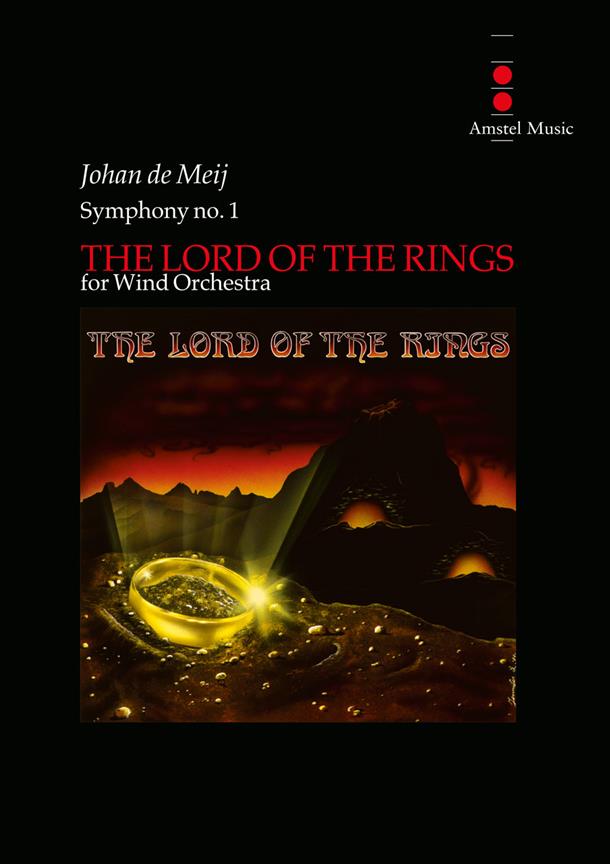Symphony No.1 The lord of the rings
Description
Johan de Meij',s first symphony "The Lord of the Rings" is based on the trilogy of that name by J.R.R. Tolkien. This book has fascinated many millions of readers since its publication in 1955. The symphony consists of five separate movements, each illustrating a personage or an important episode from the book. br> br> The symphony was written in the period between March 1984 and December 1987, and had its première in Brussels on 15th March 1988, performed by the "Groot Harmonie-orkest van de Gidsen" under the baton of Norbert Nozy. In 1989, The Symphony The Lord of the Rings was awarded a first prize in the Sudler International Wind Band Composition Competition in Chicago, and a year later, the symphony was awarded by the Dutch Composers Fund. In 2001, the orchestral version was premiered by the Rotterdam Philharmonic Orchestra and recorded by the London S ymphony Orchestra. br> br> Although it is not simple to summarize such an extensive and complex work, the main outline is als follows: the central theme is the Ring, made by primaeval forces that decide the safety or destruction of the World. For years it was the possesion of the creature Gollum, but when the Ring falls into the hands of the Hobbits the evil forces awake and the struggle for the Ring commences. There is but one solution to save the World from disaster: the Ring must be destroyed by the fire in which it was forged: Mount Doom in the heart of Mordor, the country of the evil Lord Sauron. br> It is the Hobbit Frodo who is assigned to carry out this task, and to assist him a company, the Fellowship of the Ring, is formed under the leadership of Gandalf, the wizard, which includes the Hobbits Sam, Peregrin and Merin, the Dwarf Gimli, the Elf Legolas, Boromir and Aragorn, the later King. The Companions are secretly followed by Gollum, who does not shun any means, however perfidious, to recover his priceless Ring. However, the Companions soon fall apart, after many pernicious adventures and a surprising d?nouement Frodo and Sam can at last return to their familiar home, The Shire. br> br> Explanation of the five movements: br> I. GANDALF (The Wizard) br> The first movement is a musical portrait of the wizard Gandalf, one of the principal characters of the trilogy. His wise and noble personality is expressed by a stately motiff which is used in a different form in movements IV and V. The sudden opening of the Allegro vivace is indicative of the unpredictability of the grey wizard, followed by a wild ride on his beautiful horse "Shadowfax". br> br> II. LOTHLORIEN (The Elvenwood) br> The second movement is an impression of Lothlórien, the elvenwood with its beautiful trees, plants, exotic birds, expressed through woodwind solo's. The meeting of the Hobbit Frodo with the Lady Galadriel is embodied in a charming Allegretto; in the Mirror of Galadriel, a silver basin in the wood, Frodo glimpses three visions, the last of which, a large ominous Eye, greatly upsets him. br> br> III. GOLLUM (Sméagol) br> The third movement describes the monstrous creature Gollum, a slimy, shy being represented by the soprano saxophone. It mumbles and talks to itself, hisses and lisps, whines and snickers, is alternately pitiful and malicious, is continually fleeing and looking for his cherished treasure, the Ring. br> br> IV. JOURNEY IN THE DARK br> The fourth movement describes the laborious journey of the Fellowship of the Ring, headed by the wizard Gandalf, through the dark tunnels of the Mines of Moria. The slow walking cadenza and the fear are clearly audible in the monotonous rhythm of the low brass, piano and percussion. After a wild persuit by hostile creatures, the Orks, Gandalf is engaged in battle with a horrible monster, the Balrog, and crashes from the subterranean bridge of Khazad-Dûm in a fathomless abyss. To the melancholy tones of a Marcia funèbre, the bewildered Companions trudge on, looking for the only way out of the Mines, the East Gate of Moria. br> br> V. HOBBITS br> The fifth movement expresses the carefree and optimistic character of the Hobbits in a happy folk dance; the hymn that follows emanates the determination and noblesse of the hobbit folk. The symphony does not end on an exuberant note, but is concluded peacefully and resigned, in keeping with the symbolic mood of the last chapter "The Grey Havens" in which Frodo and Gandalf sail away in a white ship and disappear slowly beyond the horizon.
Moeilijkheidsgraad: 5,5
 |
Klik hier voor een geluidsfragment |
 |
Klik hier voor een partituur-fragment |
